Today many folks, of all walks of life are participating in Precision Rifle Series competitions. The study of precision rifle has grown by leaps and bounds over the last 20 years. The quality of rifles, the types of ammo & calibers available, the evolution of equipment and the massive improvement in optics is stunning. Not to mention the introduction of ballistic software and aids is astonishing. The Global War on Terror pushed forward technologies, methods, tactics and procedures for military and law enforcement snipers, far beyond what was even imagined. The technical and technological superiority, sophistication and training of personnel are far beyond what we envisioned, even as recently as 1999. If you’re not attending training, meeting with peers, training regularly, and staying abreast of the newest innovations, you are falling behind, and fast. With this is mind I’m constantly attending training and learning from the newest generation of shooters and professionals. With every class I attend, I learn new techniques and useful methods improving my skills.
On December 7th through the 11th I attended the Advanced Sniper course, at Max Ordinate Academy in Apple Valley California. Max ordinate academy is a veteran owned and operated Precision Rifle training establishment headquartered in Las Vegas, NV. The training facility is located in Apple Valley, California. MOA encompasses several thousand acres of a remote and isolated region of the county of San Bernardino. The company was established in 2013 by Mr. Tyler Hughes, Marine Scout Sniper and Recon Marine with combat service. Upon discharged from the U.S. Marines, Tyler worked as an overseas security contractor. During his time as contractor he felt there was a need for professional level in-depth training, relative to Precision Rifle and LE Sniper operations. With this in mind he set his goals on building a training institution that would raise the bar. MAX Ordinate seeks to become the standard for civilian precision rifle and Law Enforcement Sniper training in the United States. The institution provides all levels and types of long rifle training for the beginning to the expert; for Law Enforcement, Military, security and the citizenry at large.
Author’s relevant background: attended over 23 different courses of instruction relative to this subject matter “precision rifle” and “sniper”. He served as a Law Enforcement SWAT Sniper and instructor, for over 20 years. Additionally serving as an US Army Sniper, assigned to an Infantry Battalion Sniper detachment for 8 years, with a final assignment as the Sniper detachment team leader.
This class is restricted to US Citizens, military and Law Enforcement only. There are several topics instructed within this class that will not be discussed as per the request of MAX ordinate.
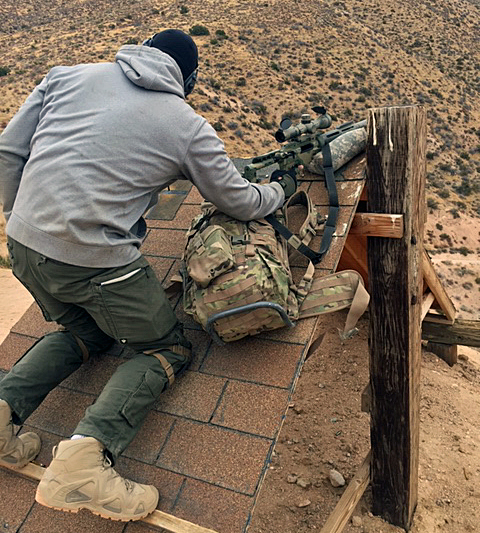
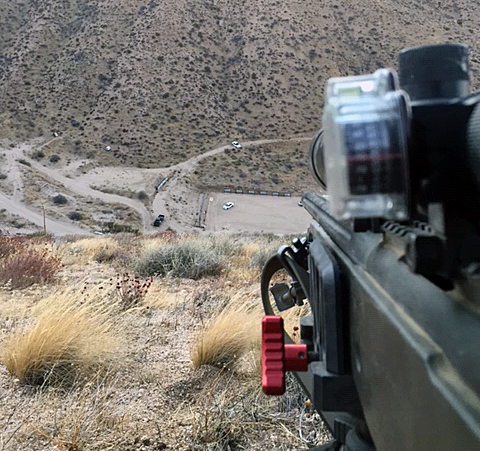

Day #1 / 0700-1700
- Individual and staff introduction
- Weapons checks
- Equipment checks
- Course objectives
- Classroom lecture
- Checking zero of rifles
- Shoot qualification course
- Shooting out to 300 yards
- After action report & review
Approx. 150 rounds fired
Upon class start time you will be provided a Student Course Booklet, a custom Max Ordinate Data-book, Tripod, Rifle Rest, Sling, Pocket reference card. This day was an overview of expectations, learning the foundational concepts of the precision rifle use and application.
Day #2 0700-1700
- Classroom lecture
- Wind solutions & estimation
- Use of optics
- Slope firing methods and determination formulas
- Use of Tri-pods
- Use of ballistic software
- Live fire range operations, shooting out to 400 yards
- Shooting moving targets, calculation of moving target leads based on speed and distance
- Introduction to shooting with Tri-pods and artificial support
- Angle firing practical application exercises out to 500 yards
- Barricade firing practical exercises and introduction
Day #3 0700-0000hrs
- Multi-positional (course #1) and station barricade firing round robin exercise shooting to 300 yards. These were steel plate targets at multiple distances, positions and angles of engagement.
- Tri-pod shooting exercises and methods
- Shooting moving targets out to 200 yards (50, 100, 200).
- Unsupported standing, kneeling and sitting on steel plates at 100 yards
- Classroom lecture
- Loophole shooting methods and techniques
- Obstacle supported shooting positions
- Alternate supported shooting positions
- Practical exercises, Loophole shooting
- Multi-positional (course #2) and stationary barricade firing, round robin exercise shooting out to 700 yards. These were steel plate targets at multiple distances, positions and angles of engagement. This course focused on shooting up hill primarily, in unconventional positions, extremely challenging.
- Night and low light shooting out to 600 yards. The targets are illuminated at the base with only enough light to see the steel target. As part of the exercise you must range it, call your wind and shoot the target twice. This is the first time I had shot on targets with this little illumination, at these distances. Excellent drill and practical exercise, very challenging and instructive.
Day #4 0800-1800hrs
- Barricade firing drill at 100 yards on reduced targets
- Bi-Pod practice live fire at 100 and 200 yards
- Long range shooting out to 800 yards
- Extreme angle firing, up and down hill
- Live fire moving targets
- Live fire practice the entire day
Day #5 0700-1700hrs
Qualifications courses of fire the entire day. Multiple stages, complexities and requirements.
- Stage 1, large paper targets multiple requirements. Dominate hand and support firing, gas mask, tripod fire and barricade fire. 56 round course 60 points possible, 51points is passing.
- Stage 2, moving targets from (3 moa targets) 50, 100 and 200, firing from barricades and tripods, you must hit 100%.
- Stage 3, long range steel targets (3 moa Targets) 200- 750 yards, max 2 shots per steel. All firing is from standing, kneeling and sitting with tri-pod.
- Stage 4, barricade running course (3 moa targets) 150-350 yards 6 positions, you must use environmental structures for support only, 1 shot at each, allowed 1 miss then fail. Two total misses is failure of course.
You must pass all 4 combined courses to qualify. The wind here ranges from 3-30mph depending on the conditions.

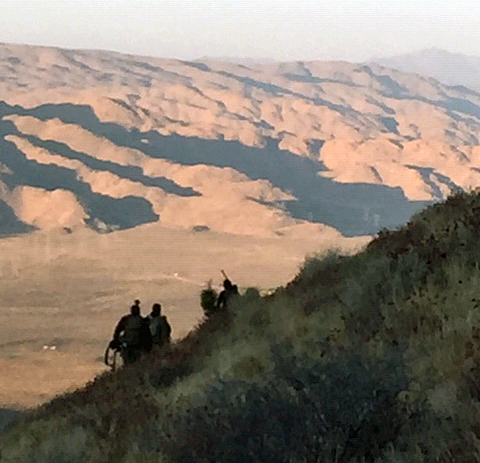
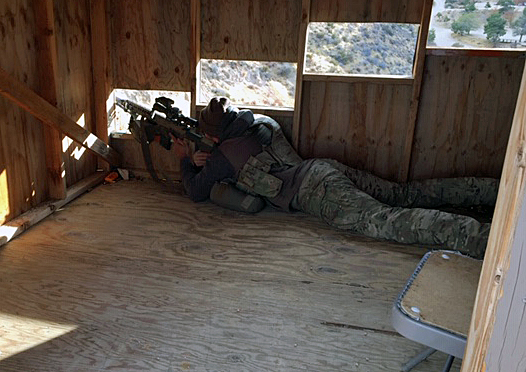
Excellent instructional aids
- Power point
- Clear and concise student notebooks with solid reference material
- All students additionally received power points, videos and instructional material to support instruction.
- Instructors well prepared and very knowledgeable
Instructor profile
- Tyler Hughes, Max Ordinate Academy lead instructor
Former US Marine Sniper and Recon Marine with combat service. He has been competing professionally for over 10 years, in conjunction with running operations and training for Max Ordinate Academy. Tyler holds multiple long distance national and regional match titles. He is the winner of the 2019 Steel Safari by Competition Dynamics.
Student profiles
Eleven personnel total, including the author
- Seven Law Enforcement
- Police
- Sheriff
- All personnel are assigned as SWAT snipers and have completed a basic sniper course.
- Average service time as a group was 8.0 years.
- Three military personnel
- US-DOD SPECOPS
- All completed basic military sniper course and advanced courses
- Average service period 9 years
- US-DOD SPECOPS
All personnel have employed and deployment with their weapons systems, in call outs and military deployments. Many of the students were having advanced knowledge combined with extensive experience in this discipline.
Comments of students
Positives
- Clear objectives, good foundational adult learning methodology applied. Excellent written support information, student handouts, excellent supporting videos and power point presentations. Each student instructor received an in-depth notebook, tripod and gun saddle device for the tri-pod. In addition each student received a colored range card with wind and range come ups and a card for and a comprehensive Instructor lesson plan notebook
- All practical application supported the plan of instruction and validated learning points brought forth by the instructor.
- A step by step approach with progressive building blocks of instruction facilitated rapid emersion and understanding of the techniques
- Conduct, appearance and presentations of the instructor exceeded expectations.
- Moving target engagements and forum.
- Loophole shooting exercises and methods was extremely informative and useful for everyone.
- Extremely thorough course of instruction, and non-compromising.
Negatives
- Lack of applicability of long range shooting for Law Enforcement officers relative to their responsibilities and roles.
- Excessive qualification courses of fire consuming the entire last day of training. Several wanted to train further on honing their skills instead of qualifying.
All participants had extremely positive reviews of the course in general, and highly recommending the class. The students overall rated this class an 8.5 from 1 to 10, 10 being best and 1 being worst.
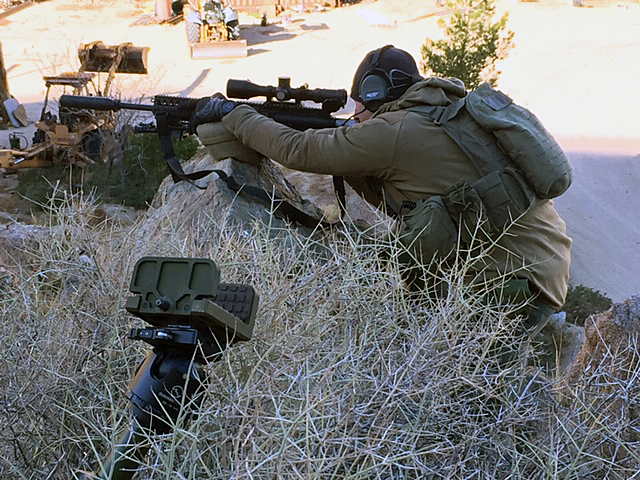

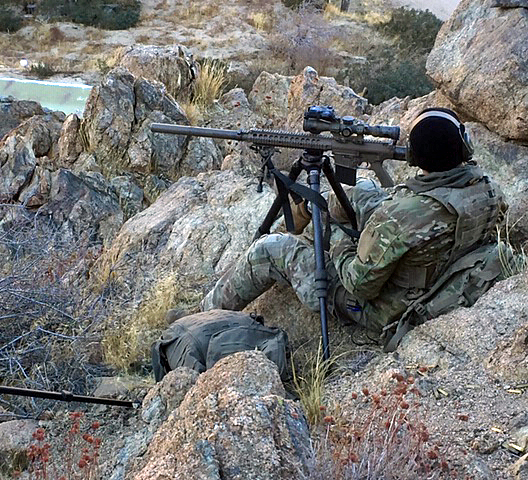
Conclusion
Overall the course was excellent, useful, well researched and extremely comprehensive. I was tremendously impressed with the information and detail of the course of instruction. Without question this was one of the best, if not the best sniper course I have ever attended.
The two most interesting and informative topics were
- Extreme angle firing
- Tri-pod use for standing and kneeling position
Although I was familiar with all the techniques, Tyler was able to simplify the process, and streamline the application of the methods in the field. This accelerated the method and sped up the protocols for use. Fewer complex steps, faster and much simpler methods. Example when firing on angles we used the “rule of 15”. Here’s how this is used and accomplished. 1st Determine the angle of the target and the distance. 2nd Minus 15 from the angle degree (example 30 degrees -15 =15) 3rd Convert this into a percentage (example 30 -15 =15%) and minus that percentage from the range, this is now your adjusted final shooting distance.
Example “RULE OF 15”
600 Yards, 30 degree angle, 30 -15 =15, now 15% from 600 Yards, -90 from 600 = 510 yards is the final firing solution and distance. Shoot the target as if at 510 yards, not 600.
Shooting with and from the tri-pod, I found this extremely difficult and trying. Tyler coached me through the process. The key of shooting accurately with the Tri-pod is allowing the Tri-pod to do the work. This took me some time to grow accustomed to and perform correctly. I continually fought the Tri-pod and attempted to muscle it into submission. This is incorrect and highly frustrating. In the standing position the key is to set the rifle correctly into the vise on the Tri-pod, tighten it and attach the sling to front sling swivel and the other end to your belt, then reversing your supported hand grip locking the elbow extending the arm. Always use a pack or large pad against the body to rest your dominate side elbow on and lock it into your side. This works in the standing, kneeling, and sitting position to stabilize the rifle, and your muscles, providing more bone support and stability. My shooting in these positions increased in accuracy tremendously in a short period of time, with these methods and the coaching of Tyler.
Forget about shooting from a prone relaxed position, not going to happen in the advanced courses. This is an extremely demanding course, not for beginners and not for those in moderate to good physical condition. Bring your “A game”, if you attend this course, this is a serious class with a high level of difficulty and very challenging. This course is both mentally and physically demanding. You must have a solid foundation in the basics. This is not a beginner’s class. This specific course was an Advanced Law Enforcement sniper school. I was very impressed with the entire course of instruction, support, material and entire facility.
Things you’ll need:
- Long range precision rifle (preferred capability of 1 MOA accuracy or better)
- Scope (Open Tactical Turrets, Minimum 10x magnification, adjustable parallax recommended, Turret adjustments with matching reticle measurements is recommended)
- 600 rounds of appropriate caliber ammunition (500 minimum)
- Bipods or shooting bag/rest
- Shooting mat (recommended, not required)
- Binoculars (recommended, not required)
- Backpack
- Call out gear I.E. vest, helmet, etc.
- Gas mask
- Tripod / Rifle saddle if you opted for the lower tuition w/o tripod option
- 2 magazines for your specific weapon platform
- Water / fluids
- Food / snacks
- Sleeping bag & pillow
- Weapons cleaning gear / lube
- Hygiene equipment (soap, shampoo, towel, etc.)
- Weather appropriate clothing (we train in all weather conditions). It is recommended to check the weather before coming to pack appropriate clothing.
- Clothing for off-range / leisure time
- Hat / skull cap / Rain Gear
- Ear protection
- Eye protection
- Sunblock
- Chapstick
- Paper & Pen
- The Ballistic ARC smartphone app (The “free” version is adequate for the course but the paid version has some very nice additional features.)
Lodging is provided as well as running hot water, the cabin is fully temperature controlled. There are multiple showers and restroom facilities, along with additional restroom facilities outside, a TV, pool table, Wifi Internet, Cable, a fully equipped kitchen with refrigerator, stove, microwave, coffee maker, charcoal and propane grill, etc. Bring your own food and an ice chest. There are plenty of beds; you will need to bring a sleeping bag. The road to the cabin and training area is regularly maintained. Normal passenger cars can pass through without much trouble; however they suggest you do not use a “lowered” vehicle.
Basic MOA qualification course phase #1 only:
Cold Bore Shot
Check and Adjust your zero
Dominate side 5 target 5 shot drill
Dominate side 5 target 5 shot mag change drill
Dominate side 5 target 5 shot single feed drill
Weak side 5 target 5 shot drill
Gas Mask Engagement drill
Type 1 Malfunction drill (Empty Chamber)
Type 2 Malfunction Drill (Double Feed)
Speed Drill – one shot 9 seconds
Speed Drill – three shots 17 seconds
Speed Drill – three shots break position drill 60 seconds
Unsupported engagements – standing kneeling seated prone (no Bipods)
After the qualification you’ll debrief, discuss all fundamental issues or shortcomings before we start the classroom portion of the Advanced Sniper Course. If you’re interested in this topic (precision long rifle) and want to know more about this discipline, and improve your skills, contact them directly. They offer beginning classes, intermediated and advanced courses. In addition they offer one day training sessions every month regularly. These courses also include free lodging.
Max Ordinate has many instructional and in-depth videos posted on YouTube, make sure to check them out.
Max Ordinate Academy contact information
Website: https://www.maxordinate.com/
Contact phone number Phone:(760) 845-5350
About the author: Monte is a former (honorably retired) State of California Peace officer (27 ½ years of service) and SWAT member (22 ½ years), former US Marine, and US Army 24 years of service, both active and reserve US Army SOF SNCO.
